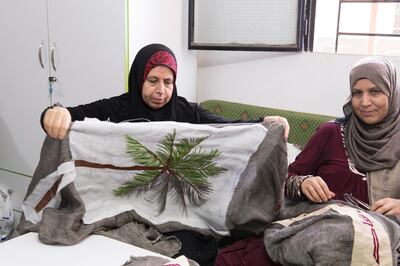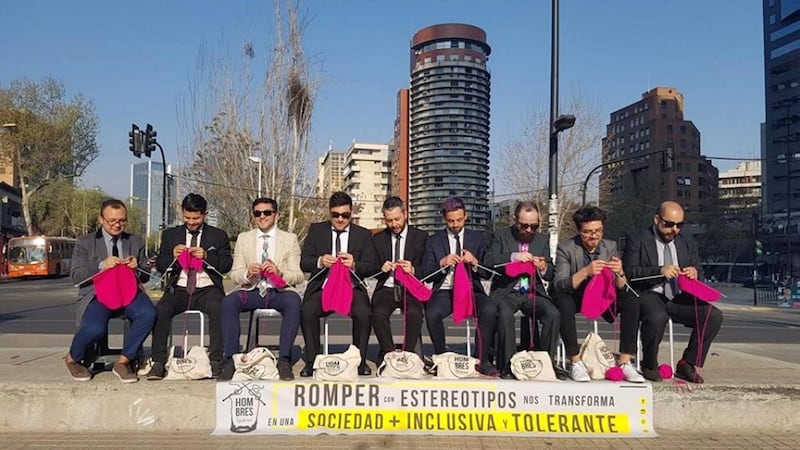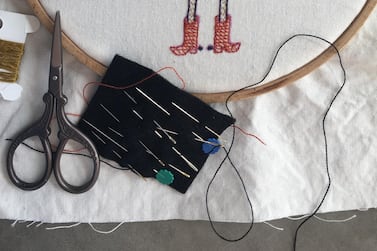Sewing, knitting and embroidery have historically been considered activities that fall under a woman's domain, rooted in domesticity and wifely duties. Perhaps this is why these have also become symbols of subversion, rebellion and activism over the decades.
In the early 20th century, the women’s suffrage movement used craft as a means of liberation. Activists produced and brandished hundreds of embroidered banners proclaiming their right to vote in public demonstrations. In prisoner-of-war camps, women used quilting as their only means of claiming private space and personal expression, in an environment where numbers replaced names. Elsewhere, doctors used embroidery as a means to help heal war veterans suffering from shell shock.
American writer Betsy Greer coined the term craftivism in 2003, which she defined as a form of activism typically incorporating elements of feminism and anti-capitalism. Greer also wrote a book on the topic, Craftivism: The Art and Craft of Activism, which includes examples of prison craft programmes and yarn bombing.
Yarn bombing, or graffiti knitting as it’s sometimes called, uses knitting and crochet as a feminised response to the predominately masculine street-art scene. It makes a statement about a woman’s place in public spaces by wrapping trees, lampposts and fences with brightly coloured yarn.
Using these skills to make a point is not restricted to women; men have employed female connotations associated with craft as a means to question stereotypes of masculinity. In Chile, a group of men known as the hombres tejedores (“men who knit”) gather in public every month. Its members are in their 20s, 30s and 40s, and hail from different backgrounds and professions; each month, they put on their suits and ties to knit with fuchsia-hued yarn, as a means of challenging a society they find too patriarchal.
Fine Cell Work, an organisation that operate in prisons across the United Kingdom, teaches the fine art of embroidery to male inmates, giving them an opportunity to earn a living, as well as find a quiet escape from their surroundings. The men are paid from the online sales of their products, which range from cushions to quilts.
Elsewhere in the UK, the Craftivist Collective creates and stitches messages addressing social and political issues, such as climate change and the refugee crisis. The messages are mailed to politicians and other influencers, and are intended to make the recipient stop and think, through the realisation of the time and energy needed to create the notes. The collective was founded by award-winning campaigner Sarah Corbett to encourage a more considered form of activism, called “gentle protest”.
In the United States, meanwhile, community enterprise The Yarn Mission was formed after the death of Mike Brown in Ferguson and in the wake of the Black Lives Matter movement. It creates a space to bring African-American communities together to heal through craft, and knit to eradicate racism and oppression. The Mission now has chapters in St Louis, Minneapolis and New York.
Speaking of the Big Apple, who can forget the famous pink feline-eared hats of the 2017 Women's March that made the cover of The New York Times and The New Yorker, and filled the streets with hand-knitted fuchsia hats as a symbol of women's rights and political resistance.

Craft is also often used as a powerful means to preserve culture, particularly in the developing world. The Palestinian city of Hebron, which was awarded the title of World Craft City by the World Crafts Council in 2016, is famous for the variety of traditional crafts it produces. Thought to be one of the oldest continuously inhabited cities in the world, Hebron has over six millennia of embroidery and craft production history to fall back on. Today, traditional crafts act as symbols of identity, pride and commerce, providing skills and income to a region in desperate need.

In a day and age where we purchase everything from our tea to our clothing, craft has become an important symbol of anti-capitalism and consumption. It is no longer the domain of white-haired empty nesters knitting tea cosies to fill the time; rather, a wave of predominately female artists have incorporated craft into their work as a means of exploring issues of gender, politics, patriarchy and activism. As opinion writer E Tammy Kim said in The New York Times: "When I pick up a needle and thread, I join a long line of women who have turned the domestic arts into political expression."
A far cry, too, from the image of the meek homemaker filling her time; the renewed interest in skills such as embroidery and knitting has given birth to the Etsy generation, which uses craft as an alternative to a nine-to-five job and as a means of supplementing income.






